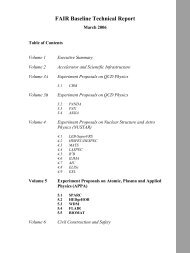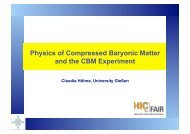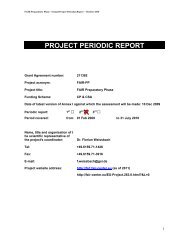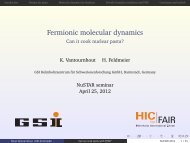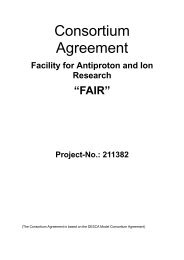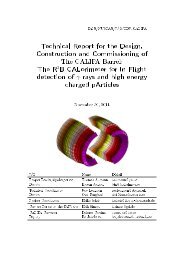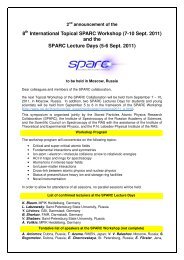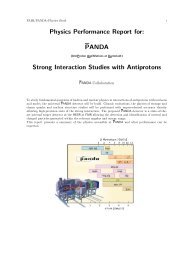NeuLAND - FAIR
NeuLAND - FAIR
NeuLAND - FAIR
Create successful ePaper yourself
Turn your PDF publications into a flip-book with our unique Google optimized e-Paper software.
is purely of academic interest. Further electrical and in-beam tests, aging issues, and<br />
simulations are addressed in Ref. [Yak-11].<br />
B.4. Construction and Test of a Full-Size 200 cm × 50 cm<br />
Prototype<br />
The center of the detector consists of 19 stainless steel anode strips (0.4×2.5× 200 cm 3 ),<br />
which also serve as converters, converting the primary neutron to a secondary charged<br />
particle.<br />
On either side of the anode there is a standard MRPC glass-gap structure with two gas<br />
gaps, in order to detect the secondary charged particle. Semiconductive mylar sheets<br />
provide high voltage and ground to the glass. Further out on each side is the signal<br />
cathode, made by copper strips. The covers of the box are made from 2 mm stainless<br />
steel for conversion. For mechanical reasons, two such structures are built in one frame<br />
with a common gas volume. There is a 2.5 mm gas gap between signal cathode and<br />
converter plate box that is needed to increase cathode impedance. Rubber tubes with<br />
fishing line inside keep the gas gap at its nominal width (figure B.2).<br />
The strip impedance is about 13 Ω, defined by the geometry of detector and the limitation<br />
on the adopted strip width of 25 mm. In order to reach 50 Ω impedance, the strips should<br />
have a width of just 3-4 mm, which is unrealistic as the readout would require too<br />
many electronic channels. Because of this impedance mismatch there is an unavoidable<br />
reflection at twice the distance from the place of interaction to the far end (as seen from<br />
the readout electrode) of the strip, i.e. 2×1 m for the case when the beam is in the center<br />
and 2×7.5 cm for the case when the beam is on the left side.<br />
Due to the large width of 50 cm and the relatively thin housing of just 2 mm steel, the<br />
box bulges outward by 1.5 mm in the center. This can be a problem for the mechanical<br />
stability of the inner structure. It is solved by a pump generating about 100 Pa<br />
underpressure inside the chamber, compensating the deformation.<br />
The ELBE in-beam tests of full size prototypes (200 × 50 cm) show satisfactory results<br />
for efficiency (>90%) and time resolution (σ < 100 ps) for minimum ionizing particles,<br />
for the whole area of the detector (figure B.6). It should be noted that the time resolution<br />
aim can be reached both by the standard FOPI FEE1-based readout and also the<br />
TACQUILA-based readout, even for the 2 m long prototype HZDR201b.<br />
In 2012, a test with neutrons from the breakup of deuteron beams will be performed at<br />
GSI (see section 8.1), including mainly scintillator-based <strong>NeuLAND</strong> solutions, but for<br />
comparison also this prototype and the converter-less one are described in section B.7.<br />
105





